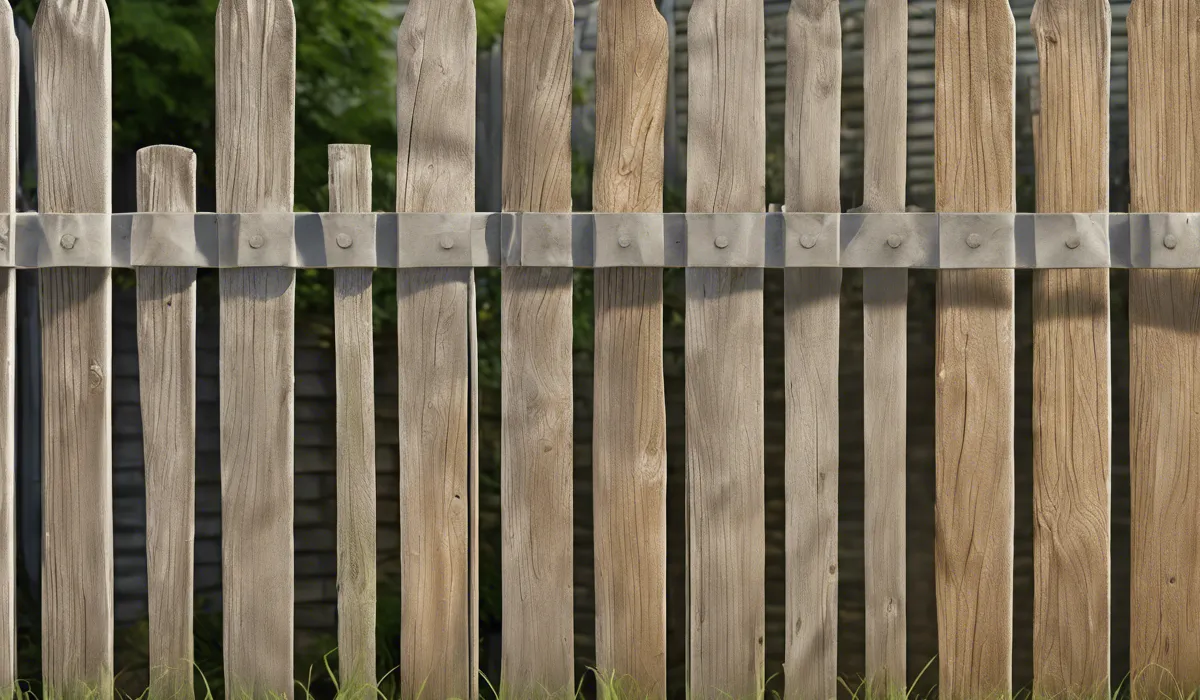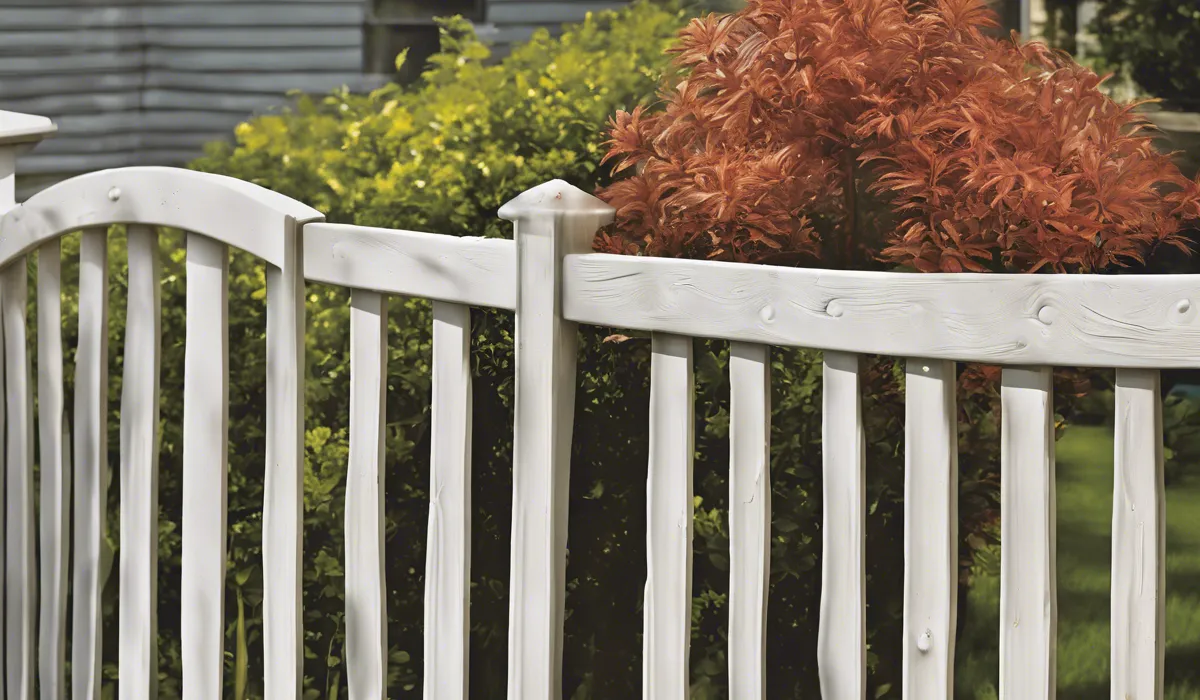To clean mildew from a vinyl fence, mix 1 part vinegar with 2 parts water. Apply the solution with a soft brush, scrubbing gently. Rinse the fence with a hose to remove the vinegar solution and dislodged mildew.
Understanding Mildew on Vinyl Fences

Defining Mildew and Its Distinction from Mold
Mildew is a type of fungus that thrives in warm, moist environments, often appearing as a thin, powdery coating.
Unlike mold, which can penetrate surfaces, mildew tends to stay on the surface, making it easier to clean.
Mold is generally black or green, while mildew usually appears white or gray. Understanding this difference is crucial when it comes to cleaning and prevention.
Causes of Mildew Growth on Vinyl Fences
Mildew on vinyl fences often results from prolonged exposure to moisture and lack of sunlight. Sprinklers, rain, and high humidity contribute to its growth.
Areas that are shaded and have poor air circulation are particularly susceptible. Additionally, organic debris like leaves and dirt can support mildew growth on your fence.
Impact of Mildew on Fences
While vinyl is durable and resistant to many elements, mildew can mar its appearance, giving it a neglected look.
Over time, if left unchecked, mildew can cause the material to degrade, potentially shortening the lifespan of your fence.
Identifying Mildew on Your Fence
Spotting mildew early is key to maintaining your fence. Look for any unusual stains or discolorations, particularly in areas that don’t get much sunlight.
You might notice a dusty or fluffy appearance on the surface, which indicates mildew presence.
Preparing to Clean Your Vinyl Fence

Safety First: Protective Gear
Before tackling the mildew, ensure your safety by wearing protective gear like gloves and goggles. This will help prevent irritation from cleaning solutions and debris.
Optimal Weather Conditions for Cleaning
Choose a cloudy day for cleaning to prevent the quick evaporation of cleaning solutions, which can reduce effectiveness.
Ensure there is no rain in the forecast to allow your fence to dry properly after cleaning.
Gathering Materials and Tools
You will need a bucket, water, a garden hose, a soft-bristle brush, and cleaning solution. Depending on your choice, prepare either a homemade mixture or have a commercial product ready.
Choosing Between Homemade and Commercial Cleaners
Homemade cleaners, like a vinegar and water solution, are eco-friendly and cost-effective.
Commercial products, on the other hand, are often more potent and may yield quicker results but can contain harsh chemicals.
Weigh the pros and cons based on your preferences and the severity of the mildew.
Step-by-Step Guide to Cleaning Mildew from Vinyl Fences

Initial Rinsing of the Fence
Begin by rinsing your fence with a garden hose to remove loose dirt and debris. This step prepares the surface for a more thorough cleaning by allowing the cleaning solution to focus on the mildew.
Applying the Cleaning Solution
Mix 1 part vinegar with 2 parts water in a bucket. Apply this solution to the fence using a soft brush, starting from the top and working your way down to prevent streaks. Cover all affected areas thoroughly.
Scrubbing the Mildew Away
Using the soft-bristle brush, scrub the fence gently to remove the mildew. Pay special attention to grooves and crevices where mildew may be more stubborn.
The gentle motion helps protect the vinyl surface from scratches.
Rinsing Off the Cleaner
After scrubbing, rinse the fence thoroughly with the hose to remove all traces of the vinegar solution and dislodged mildew.
Ensure that no residue is left behind, as this can attract dirt and promote future mildew growth.
Drying and Inspecting the Fence
Allow the fence to air dry completely. Once dry, inspect the fence for any remaining mildew spots.
If necessary, repeat the cleaning process on stubborn areas to ensure a clean and mildew-free surface.
Preventing Future Mildew Growth
To minimize the risk of mildew returning, trim back any overhanging branches to increase sunlight exposure.
Ensure sprinklers are not directly hitting the fence, and routinely clear away organic debris. Consider applying a UV protectant to the vinyl for added protection.
FAQs About Cleaning Vinyl Fence Mildew
What is the recommended vinegar to water ratio for cleaning mildew off a vinyl fence?
The recommended vinegar to water ratio for cleaning mildew off a vinyl fence is 1 part vinegar to 2 parts water.
Can I use a regular brush to scrub mildew off my vinyl fence?
It’s best to use a soft brush to gently scrub mildew off a vinyl fence to avoid scratching the surface.
How do I rinse the fence after applying the vinegar solution?
Rinse the fence with a hose to remove the vinegar solution and any dislodged mildew.
Is it necessary to use a vinegar solution to clean a vinyl fence?
While not always necessary, a vinegar solution is often recommended for cleaning mildew from a vinyl fence because it’s a natural and effective mildew remover.
Should I scrub the vinyl fence vigorously to remove the mildew?
No, you should scrub gently to avoid damaging the vinyl fence while removing the mildew.
Final Thoughts
For removing mildew from a vinyl fence, a simple cleaning solution of 1 part vinegar to 2 parts water is effective.
Use a soft brush to apply this mixture, scrubbing the area gently to lift the mildew. Finish the cleaning process by thoroughly rinsing the fence with a hose to wash away the vinegar mixture and any remaining mildew remnants.
Useful Resources
- https://www3.epa.gov/pesticides/chem_search/ppls/004091-00019-20220211.pdf
- https://msdh.ms.gov/msdhsite/handlers/printcontent.cfm?ContentID=21043&ThisPageURL=http%3A%2F%2Fmsdh%2Ems%2Egov%2Fmsdhsite%2Findex%2Ecfm%2Findex%2Ecfm&EntryCode=21043&GroupID=44
- https://www.cdph.ca.gov/Programs/CCDPHP/DEODC/EHIB/CPE/CDPH%20Document%20Library/Mold/MMIMH_English.pdf
